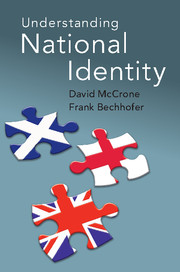Book contents
- Frontmatter
- Contents
- List of tables
- Preface
- Introduction
- 1 Thinking about national identity
- 2 Accessing national identity
- 3 National identity: do people care about it?
- 4 Debatable lands: national identities on the border
- 5 Claiming national identity
- 6 The politics of national identity
- 7 The notional other: ethnicity and national identity
- 8 A manner of speaking: the end of being British?
- 9 Whither national identity?
- Appendix National identity publications
- Bibliography
- Index
2 - Accessing national identity
Published online by Cambridge University Press: 05 April 2015
- Frontmatter
- Contents
- List of tables
- Preface
- Introduction
- 1 Thinking about national identity
- 2 Accessing national identity
- 3 National identity: do people care about it?
- 4 Debatable lands: national identities on the border
- 5 Claiming national identity
- 6 The politics of national identity
- 7 The notional other: ethnicity and national identity
- 8 A manner of speaking: the end of being British?
- 9 Whither national identity?
- Appendix National identity publications
- Bibliography
- Index
Summary
If, as we argued in the previous chapter, national identity matters, that it is important to social actors, as well as being a useful concept for explaining their attitudes, actions and behaviours, how do we study it – in other words, how do we ‘get at’ national identity? This is not simply a matter of adopting the best research method, assuming such a thing ever exists, or a variety of methods, but closely connected with how we conceptualise national identity in the first place. In this chapter, we will give an account of our understanding of national identity, how we went about studying it, the methods we employed and the research designs we adopted. We will discuss our findings in the chapters which follow.
There are two influential views in this regard. Firstly, there is the commonsense view, shared as we have seen by some theorists, that national identity is a fixed badge, something we all have been given, derived from our ‘nationality’, and there is little more to be said. Once we have it, a bit like an identity card, we are what it says on the tin. From this perspective, we can use it or ignore it, but there is nothing much we can do to change it, short of emigrating and taking another citizenship, or perhaps forging another identity. That, though, is wrongly to equate national identity with ‘nationality’, or citizenship. Nor is it simply a matter of where you were born. National identity is much more subtle and variable than that. It will probably be clear to the reader that living and working in Scotland has been a major influence on our thinking. ‘Nationality’, British citizenship, is not at all the same as ‘national identity’, being Scottish or indeed English. Our understanding of national identity, then, comes literally with the territory.
- Type
- Chapter
- Information
- Understanding National Identity , pp. 22 - 42Publisher: Cambridge University PressPrint publication year: 2015



